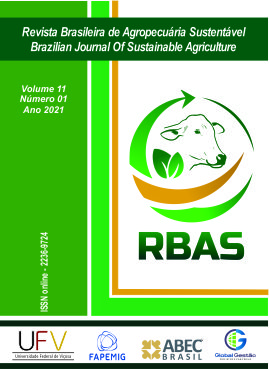FIBER OF COCONUT IN SUBTRACT COMPOSITION TO PAPAYA SEEDLINGS
DOI:
https://doi.org/10.21206/rbas.v11i1.11588Keywords:
Carica papaya L., Cocos nucifera L., bovine dungAbstract
The processing of coconut generates residues with a significant volume, whose disposal in the environment causes serious problems. One solution would be to use it after defibration in the production of substrate for seedling production. Based on this, the objective of this work was to identify the amount of coconut fiber associated with bovine dung in the substrate for the formation of papaya seedlings. The experiment was carried out in a randomized block design with 5 replications, with substrates being produced in five ratios of coconut fiber for cattle dung (0: 1; 1: 3; 1: 1; 3: 1; 1: 0 ), sown with papaya formosa and 50 days after sowing, evaluations of shoot length and root system, stem diameter, number of leaves, shoot dry mass, root system, total and water retention capacity in substrate. The data were subjected to analysis of variance and polynomial regression at 5% probability. There was significance only for the parameters of the aerial part of the seedlings. The use of up to 44.38% of the coconut fiber used with 55.62% of cattle dung is recommended for the production of papaya seedlings.
Downloads
Downloads
Published
How to Cite
Issue
Section
License
Copyright (c) 2021 Brazilian Journal of Sustainable Agriculture

This work is licensed under a Creative Commons Attribution-NonCommercial-NoDerivatives 4.0 International License.
1. Proposta de Política para Periódicos de Acesso Livre
Autores que publicam nesta revista concordam com os seguintes termos:
Autores mantém os direitos autorais e concedem à revista o direito de primeira publicação, com o trabalho simultaneamente licenciado sob a Licença Creative Commons Attribution que permite o compartilhamento do trabalho com reconhecimento da autoria e publicação inicial nesta revista.












